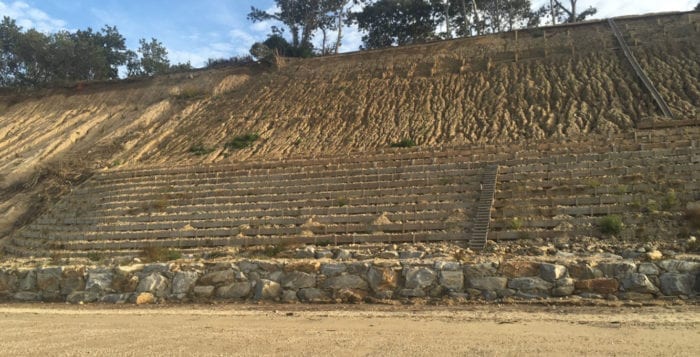By R. Lawrence Swanson
Much has been proposed, written, and even implemented, to sustain, armor, adapt, make resilient and conserve the low-lying areas of Long Island’s South Shore since Hurricane Sandy five years ago. That coast is vulnerable to extensive inundation by accelerated sea level rise, the vagaries of storm surges and climate change. Indeed, there are core areas that now flood regularly on the semi-monthly spring tides.
The North Shore of the Island has been largely neglected in the sea level rise/storm surge discussions and planning even though it is equally vulnerable to these processes. The entire geomorphology of the North Shore is subject to change with or without anthropogenic intervention. The challenge is to be able to manage this change so that the environmental services — harbors of refuge, beaches, wetlands, fisheries, aesthetics — provided by the complex, precarious topography of the North Shore remain functionally stable for the region, communities and private interests.
Much of the North Shore is composed of unconsolidated morainal bluffs — many 50 feet or higher — accompanied by down-current cobble barrier beaches. These spits form the small pocket bays and harbors that are the locations of historic settlements. They provide refuge for people and marine ecosystems from the energy of waves and storms. The beautiful pocket bays of Mount Sinai, Port Jefferson, Stony Brook, Northport, Huntington, Cold Spring Harbor and Oyster Bay are now the cultural centers of the North Shore.
The protective spits that form these bays are fed by erosion of the adjacent coastal bluffs. In order for the pocket bays to be maintained, spits must have a sufficient sediment supply to overcome erosional forces and sea level rise, which is currently increasing at about 1.5 feet a century in Long Island Sound, but undoubtedly will accelerate here and globally. The general process is that the bluffs are undercut at their base or toe by waves and extreme tides. This undercutting will become more severe as sea level rises and we experience greater and longer lasting storm surges in the coming years. The bluffs then slump — about 2 feet per year — creating new beach material, some of which is transported by littoral (near-shore) currents to create and sustain the barrier spits. The small beaches at the toe of the bluffs reduce the wave run-up and thus bluff erosion.
“The North Shore of the Island has been largely neglected in the sea level rise/storm surge discussions and planning even though it is equally vulnerable to these processes.”
— R. Lawrence Swanson
Construction of seawalls for which there is increasing demand along the bluff faces hinders these natural processes. Beaches fronting the bluffs will disappear so that waves will be beating directly on the seawalls. Little material will be available for transport to maintain the barrier spits with rising sea level. Those spits will then be subject to overwashing — perhaps exposing the embayments behind continuously to the open waters of the Sound.
What can be done in the way of resiliency to preserve the character of the North Shore and yet also protect individual properties on the Sound — both those on the cliffs and those on the barrier spits? Is hardening the bluffs and beaches at great expense the answer? Do we let nature take its course? Do residents on the barrier beaches have rights to the sediment of eroding cliffs in much the same way that downstream California claims rights to Colorado River water? If hardening of bluffs is allowed, will there be enough sediment at the toe to maintain a beach to reduce wave run-up?
New York State needs to examine this issue and develop guidance that works for all. Current policies are confusing and perhaps conflicting. This is a regional issue that cannot be solved property by property or even on a town-by-town basis.
With the state of development on the North Shore, some form of intervention or adaptation is probably required; nature cannot be left totally unchecked, given the grim climate projections for this coming century. Extensive hardening of the shoreline is equally unpalatable. There are negative downstream effects from almost all anthropogenic solutions. We need to understand and minimize them. Once started, hardening will eventually result in entombing us, totally eliminating the natural beauty and functionality of the North Shore that we enjoy. Perhaps there are softer forms of resilience that will allow preservation of natural processes yet significantly reduce the anticipated severe erosion from wind, rain, accelerated sea level rise and climate change. We need to find those techniques and implement them consistently.
In the meantime, there are zoning measures that can be practiced that will reduce erosion of these steep coastal faces — establish respectable setbacks, reduce or eliminate clearing, minimize variances resulting in overbuilding and consider downstream impacts of stabilization measures.
Long Island’s low-lying South Shore is at risk to the negative impacts of storm surge, sea level rise and climate change and much attention is being given to it. The North Shore, while seemingly elevated from these impacts, is not. Because its steep coast consists of unconsolidated sediments, it will experience extensive erosion. We need to understand, plan for and implement regional adaptive measures to reduce potential adverse effects to assure resilience of this vulnerable coastal environment.
R. Lawrence Swanson is the interim dean and associate dean of the Stony Brook University School of Marine and Atmospheric Sciences.





